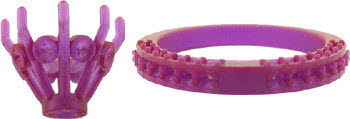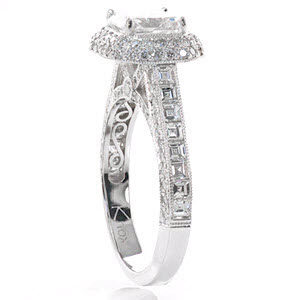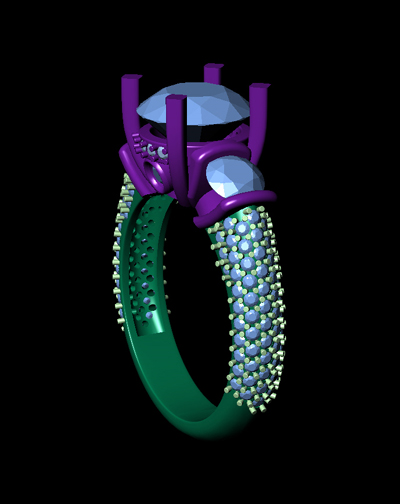Friday May 31 2007 De Beers DTC is expected to increase overall rough prices by 2-5% this week. Prices of large better quality stones are expected to increase significantly with lower prices for smaller, medium to low quality, rough diamonds.
Author: admin
Cool Diamond Pics
There really is something almost magical about looking into a diamond, so I thought that I would start a collection of interesting photos.
It is very difficult to capture the beauty of a diamond in a photograph, but like other examples of natural beauty, such as a photo of a beautiful sunset or a scenic panorama, a photo that captures the essence of a sparkling diamond can also be a work of art.
Here is a photo of a .19 carat fancy intense pink diamond we sold earlier this year.

Raw Diamond Crystals
Here are four very interesting photos of raw diamond crystals. These raw diamond crystals are the exact form that diamonds are found in nature. Note the varying body color of the diamond crystals. Most diamonds found in nature will have some tint of color, the yellow tints and brown tints are the most common. A diamond crystal without a tint of yellow or brown is very rare and desirable, these diamonds are given the top three grades of D-E-F or colorless.
It is even more rare to find fancy colors such as the fancy intense pink diamond shown in the last article.
Photos courtesy of International School of Gemology




More Pictures to come…
What is CAD-CAM?
CAD = computer aided design
CAM = computer aided manufacturing
CAD software allows designers to build a design in the exact three dimensional (3-D) geometry and dimensions desired. The beauty of using this software for customers is being able to see exactly how a proposed custom design will look before any ring is cast in the metal or before any stones are set in the metal. The software we use (Matrix by Gemvision) can generate photo-like renderings of jewelry items from every potential angle and can even be used to make a moving video of a jewelry design.
Once the design is completed in the software there are several methods to use CAM to produce an exact 3-D model from various medias than can then be directly casted into precious metal.
The technology is a perfect fit for the jewelry industry as the models made by the various CAM methods provide a much higher level of precision and symmetry than all but the very top level wax carvers (artisans that carve wax models for casting by hand)
Also, the cost for these CAM models are often quite less than having comparable models made by hand.
Nearly all of the big manufacturers and designers are using the technology and it would appear that is just a matter of time until it truly dominates the industry.
Here is a quick explanation of a couple CAM methods:
A common method used to create wax models is a CAM (Computer Aided Manufacturing) Milling System. This machine receives the model’s geometry information and drills out each and every detail. This system is very precise and accurate and the wax models milled can be directly cast into metal.


Another method used is a 3-D Grower. This CAM technology prints ultra-small layers of resin on top of one another until the model is finished. A laser follows the printing of each layer to harden the resin. The result is a very accurately detailed piece. These models can also be directly cast into metal.


Pave? or Micro-Pave?
This page is dedicated to defining micro-pave and showing different styles and ways to achieve the look. We have hundreds of Micro Pave Engagement Rings and Micro Pave Wedding Bands.

It should be mentioned that technically speaking there is much misuse of the term Pave, in fact, the word has incorrectly become nearly a ‘generic’ descriptor of any ring with small side diamonds.
Much of the fault for this misuse of the term pave falls with jewelers that do not take the time to educate and explain. In their defense, most jewelers probably find it easier (and maybe smarter) to show a customer what they want to see rather than giving a technical education in setting styles and methods.
What is Pave?
The term Pave is from the French word Pave (pah-vey), as in paving a street. The word was quite descriptive of the diamond setting style in which small diamonds are used to literally pave an area of a ring or other jewelry item.
The desired effect is to obtain an area that looks like it is paved with diamonds, with as little as possible metal showing.
I would guess that pave setting has been around for hundreds of years, maybe thousands. It is a very low-tech style of setting in which a goldsmith will drill or form holes into the selected area of a jewelry item (or possibly the entire item) and then place the corresponding size diamonds into the holes and then with another tool, form tiny beads (two or more) of metal from around the edge of the diamond and then carefully push these beads of metal over the edge of the diamond to hold the diamond in the hole.
While the setting method/style goes back to the earliest days of jewelry making and is therefore quite ancient, the finished product coming from the hands of a master setter can make for some of the most magnificently beautiful and unbelievably intricate designs.
What is Micro Pave?
As in the above mentioned misuse and overlap of ‘working definitions’ of the term Pave, the term Micro Pave also has less than an industry wide accepted standard definition. So I will simply use my definition 🙂
Micro-pave is probably best described as the highly precise setting of very small diamonds using a microscope
It should be mentioned that many purists will only consider an item ‘pave’ or ‘micro-pave’ if the item was made entirely by hand.
That said, the increased precision and efficiency made possible by CAD-CAM manufacturing methods has helped popularize a CAD-CAM version of the micro-pave setting style in which very small round diamonds are set into a design that has multiple tiny little prongs perfectly formed in the prototype or wax. (Remember, in the classic definition of pave setting, the holes for the diamonds are drilled into the actual metal and the little beads or prongs are formed by hand)
The major advance that CAD-CAM technology has brought to this process is to significantly reduce the amount of hand labor necessary for the actual setting of these very small diamonds This represents a big advance in time savings in jewelry making methods because of the perfect symmetry and precision the CAD-CAM technologies can build into the wax or prototype.
There are still many high quality makers of jewelry that may use CAD-CAM to make a custom project but not use the technology to form the tiny prongs or beads to hold the stones. Instead, they will use a highly skilled diamond setter to meticulously layout the tiny diamonds that will fit into the design and then carefully set by hand each of the tiny diamonds by drilling into the metal and then hand forming beads (prongs) etc. which as shown below is very time intensive and requires Master level diamond setters.
As with most processes, there are pros and cons to each method and the final method of choice used to make a ring is often related to a design specific reason or reasons.
Here is an example of micro pave done by hand.
There are 136 tiny little round stones all bead set by hand ( under a microscope) All the little beads (prongs) are formed in the metal by the setter.
Here is an extreme close-up of part of the design, some of these small diamonds are no bigger than .003 carat ( .80 mm diameter ) or about the thickness of 2 or 3 business cards. The tiny prongs holding these diamonds are a fraction of that size… which is why this type of work must be done under a microscope.

It is easy to lose perspective on such a highly magnified image, so I am also going to show a couple other images of the ring (which are themselves magnified several times the actual size)


Here is another excellent example of a hand cut micro pave engagement ring.

Another angle…

The design below is an example of Micro Pave where the beads were formed by CAD-CAM
The first two images are from 3-D design software.


It would be extremely tough to make a ring like this without CAD-CAM because of the difficulty in having a uniform and matching layout of the stones on a three dimensional element ( the curved band)
Solving this geometry puzzle is one of the strong suits of CAD-CAM and makes for very significant time (money) savings.
Here are a couple pics of the finished ring that was made with CAD-CAM assisted micro pave.


Any discussion of micro pave would be incomplete without touching on the issues of durability and maintenance of micro pave ring designs. As designers and makers of many micro pave designs, we are often asked the following types of questions:
(1) Are micro pave diamonds prone to falling out?
(2) Are micro pave designs hard to keep clean?
(3) Are micro pave rings harder to size?
Are micro pave diamonds prone to falling out?
Compared to other side diamond setting methods, I think the quick answer has to be yes, and here is why:
(A) Some micro pave designs may have 100-200 diamonds, which using simple arithmetic, gives many more opportunities for a diamond to fall out.
(B) Using the large image of the finished ring earlier in this article as an example, some of the micro pave diamonds are less than 1.00 mm. The prongs holding these small diamonds are a fraction of that and may be better measured in microns. Don’t forget that these tiny prongs are made from a very malleable metal. Bottom line, the amount of metal holding these small diamonds is very small and any direct hit on one of these small prongs or diamonds could easily dislodge a diamond.
Speaking of dislodging diamonds, because of the very delicate prongs holding micro pave set stones, it is not uncommon for professional cleaning methods (specifically, ultrasonics and steam cleaners) to dislodge micro pave set stones. The shear force developed by these professional quality cleaning machines can & will dislodge micro pave set stones,
That said, well made micro pave, when carefully worn and well cared for, can give many years of problem free wear. As with all jewelry, we recommend a minimum of twice yearly inspections.
Are micro pave designs harder to keep clean?
Again, the quick answer is yes (at least, relative to rings without side stones) But, we have thousands of customers that are able to keep their micro pave designs bright and sparkly with just the occasional home cleaning plus the twice yearly visit to our store.
Bottom line, all rings will need a periodic cleaning to look their best. Don’t worry about it… wear it… clean it, easy as pie.
Are micro pave rings harder to size?
Yes, and some may not be sizable at all, so it is prudent to ask this question early in any custom ring process. That said, a highly skilled jeweler is capable of sizing just about any ring.
Visit our website here: www.knoxjewelers.biz
Clarity grades… the dirty little secret
Are all SI-1 clarity diamonds eye-clean?
Are all SI-2 clarity diamonds eye-clean?
Are all VS-2 clarity diamonds eye-clean?
Are all VS-1 clarity diamonds eye-clean?
The truth may surprise many… but the answer to all four of the above questions is, no.
Here is another thought for those considering ‘buying blindly’ from the virtual list of diamonds available on the internet.
Many consumers assume that all clarity grades are uniformly identical or at least very close, Eg. “All SI-1 clarity diamonds will be eye-clean” at least all the SI-1 diamonds from the preeminent labs.
Nothing could be further from the truth, especially in the SI grades.
SI clarity stones of the same grade can vary tremendously, from eye-clean to easily visible to the naked eye. (see photo below of three actual stones, all with a Gemological Institute of America (GIA) clarity grade of SI-1)
It is helpful to think of the clarity grades as a range, and not an exact, precise, quantifiable term.
Within these ranges of clarity there are for example, good SI-1’s, bad SI-1’s and maybe even the ugly SI-1’s. ( this analogy will hold true thru the other clarity ranges as well)
It is common sense that diamond sellers that stock diamonds will buy for their own stock the nicer of these ranges of clarities and especially the nicer (eye clean) SI’s .
With the diamond sellers that stock diamonds buying only the ‘good’ SI diamonds for their stock, this of course leaves the bad and the ugly to be sold elsewhere.
Think about it.

On this very topic, here is an inquiry from a poster on an online diamond forum and my reply to the poster. He was asking if the SI-1 diamond he saw listed on a “virtual listing venue” was a good deal.
I’ve been looking to buy an engagement ring online, and have come to the conclusion XXXXXX.com has the best prices out there. For instance:
Price: $xxxx.xx
Code:
Stone shape: Round
Carat Weight: 0.91 carats
Cut: Ideal
Color: G
Clarity: SI1
Certificate type: GIA
Depth %: 62.8
Table %: 58.0
Symmetry: Very Good
Polish: Very Good
Girdle: Thin to Medium – Faceted
Culet: None
Fluorescence: None
Measurements: 6.22 x 6.16 x 3.89 millimeters
Length-to-width ratio: 1.01
To which I replied:
Hi, Welcome to the forum.
The short answer is, if the diamond is a strong SI-1 and not overly dark or dead from being marginally deep… the stone may be well priced.
The longer answer and the reality of the situation is that diamonds are essentially priced by the marketplace and by how strictly graded any particular diamond is and of course that particular diamonds cut quality.
I will only speak to the subject of clarity, but rest assured that the same market forces will affect the desirability and saleability of any diamond with regard to the diamonds Color and make and/or overall finish.
There are varying levels of SI-1 clarity diamonds (other clarities as well) and they are all priced by the supply and demand forces of the marketplace based on how strictly graded the diamond is.
Do a little research on clarity and you will find that SI-1 stones can vary from ‘clean to the naked eye’ to having ‘easily noticeable inclusions’
The diamonds on ____ ____ and many other websites are from virtual lists, these are lists of diamonds owned by cutters and wholesalers, bear in mind that most if not all of these same diamonds are available to jewelry stores and other volume buyers of diamonds but for whatever reason have gone unsold.
Of course, the most obvious and common reason for diamonds to be rejected by expert buyers is that the diamond is not strictly graded (IE. not a strong SI-1)
Certainly, there can be quality diamonds on these virtual lists also.
However, it is common sense that the longer any one diamond stays on this list, especially if it is priced ‘competitively’ the more likely it is that this particular diamond is a reject of the expert buyers that comprise the market.
Unfortunately, there is no way for consumers to tell how long a diamond has been on the market.
Consumers do not have the beneficial market forces to help the non-experts as one would have in another marketplace such as real estate, where an overpriced piece of real estate that has been on the market for years/months raises obvious red flags.
Aaaahhh… so where do these ‘rejected’ diamonds end up?
What better venue for a seller of such a stone than to be able to sell it to a consumer, sight unseen. Think about it.
His shopping is done… she has a ring on her finger… a wholesaler has sold a diamond that experts would not buy… and yet everybody is happy ?
Yes, and it is because all diamonds are beautiful, this is especially true for diamonds sold on the internet as there are not other more beautiful diamonds to compare it to. Even diamonds with noticeable imperfections in say, 3% of the visible area of the diamond may sparkle beautifully in the other 97 % of the diamond.
So… the diamond now has a happy home due to the above reason, but not without considerable help from the cognitive dissonance (the tendency in human nature to rationalize bad decisions) making this person think that his SI-1 diamond is the same as any other SI-1 diamond or that he has somehow found the deal of the century.
Speaking of which, there appears to be no shortage of people that seem to think they can swim with the sharks and out smart this ‘market place’ comprised of diamond buying experts and corporations that trade in diamonds for a living.
Hmmm? That last paragraph actually has the making of another article.
Brian Knox
Visit our website here: www.knoxjewelers.biz
